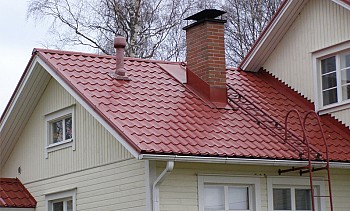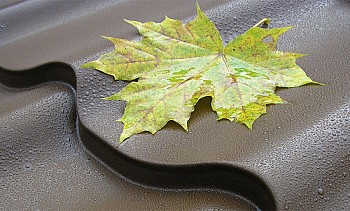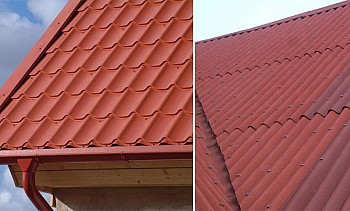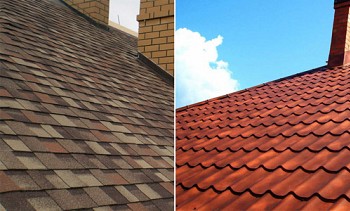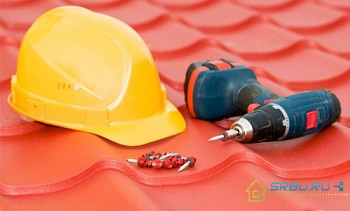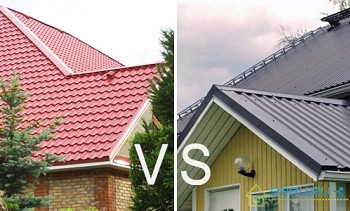This roofing material, light in weight and in installation, attracts developers with its stylish design, durability and affordable price. To help you navigate in its brands and manufacturers, consider all the main types of metal, depending on the material of manufacture base, profile geometry and polymer coating coating.
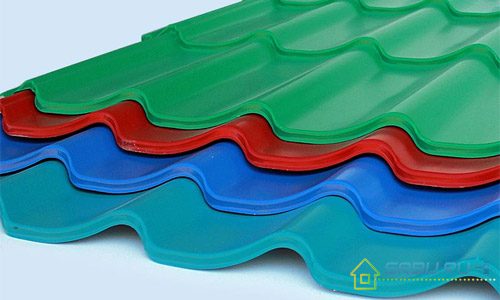
Content:
Materials used for the manufacture of metal
Steel sheet
It is galvanized steel that most often serves as the basis of metal. Its thickness can be from 0.45 to 0.55 (less often to 0.6) millimeters. Zinc coating protects the metal from corrosion. There are several more reinforcing layers on top, including polymer. In this case, steel coated with zinc or aluzinc may be used. The second coating is more durable, but the cost of such a metal tile is much more expensive.
Aluminum sheet
This metal is good in that there is no need to protect it from corrosion - it is absolutely not subject to it. However, there is an additional coating on aluminum tiles - it increases the strength and durability of the roof. And the aluminum tile is very light. That's just a little poor in her palette of shades. And it costs significantly more than a roof made of other materials.
Copper sheet
Such a tile looks noble and elegant, especially with time, when a patina of greenish patina forms on it. Architectural monuments and old houses covered with copper metal tiles look beautiful. Patina is the best protection against adverse factors, so there is no need to use any additional polymer coatings. Such a metal tile is expensive and is rarely used.
Varieties of metal depending on the geometry of the profile and the depth of the insole
Surely many have heard about such types of metal roof tiles as Monterrey, Joker, Banga and Cascade. However, there are relatively new profiles that have a very interesting design and excellent quality. These are, for example, brands such as Andalusia, Modern, Shanghai.
Metal tile with a profile of Monterrey
This roof covering, which came to us from Finland, is extremely similar to clay tiles. Thanks to this, it won the most fans. Tile Monterrey - lightweight, aesthetic, easy to install, well protected from natural disasters. The profile of this roof is smoothly rounded, which allows you to immediately recognize it, just by looking. After all, the appearance of various brands of this metal tile is very similar. The edge of the roof is decorated in the form of steps, which can be located both strictly symmetrical and asymmetrically.
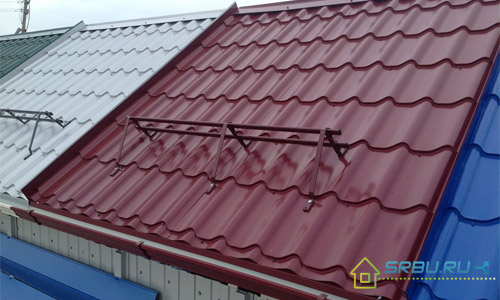
Metal Cascade Profile
This roof, a bit reminiscent of its shape chocolate bar, attracts those who appreciate the savings. The Cascade tile is distinguished by the rigor of rectangular outlines, so it is very good to cover the roof with a complex shape. It turns out to be strict, accurate and proportional. In general, this is a classic style that will never go out of style and will always be relevant over time.
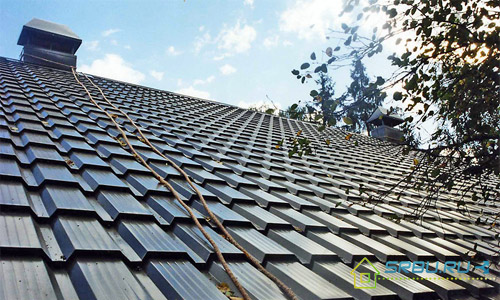
Metal tile with a profile Joker (Joker)
Round crest and sole, classic forms - these are the differences of this coating. The “right” waves create the illusion of a ceramic tiled roof. Those who appreciate tradition and classics will surely like the roof of this metal tile.
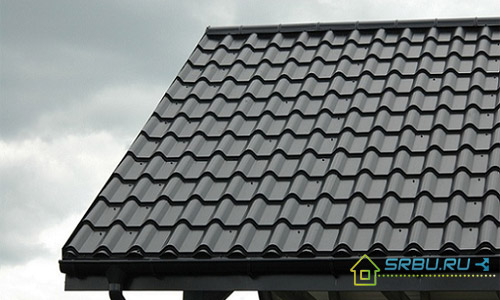
Metal tile with a Bang profile
This roof is still very young - it was recently launched. Her profile is distinguished by pretentious forms, and the exterior design shines with originality. Due to the structure of the profile and the increased wave height, a persistent three-dimensional image effect is observed. But the width of this metal tile is small, which, however, does not detract from its merits. This material is best used for the roofs of tall houses - there it looks most spectacular.

Metal tile with Andalusia profile
And again, a roofing that is quite new for our country, which has not yet become quite popular. In its manufacture uses special European equipment. It makes it possible to fix the tiles in a hidden way. And this is a big plus - even the Monterrey tile, one of the most sought-after on the market, fasteners are made openly. And the screws sometimes quite striking. But “Andalusia” not only looks great, but also has increased moisture resistance. After all, her sheets are connected tightly-tight with special locks.
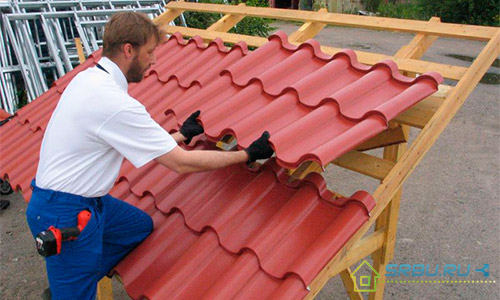
Metal Roofing with Shanghai Profile
And finally - the roof, a symmetrical pattern of which came to us from China. Russian developers learned about it later than anything else. Her sophisticated high profile (66 millimeters) is symmetrical. Thanks to this, professional sheet can also be made on equipment for the manufacture of metal tiles.

There are other types of metal tile profile, but the ones listed above are the most common. Manufacturers are constantly working in this direction, replenishing their collections with newer and newer types of metal tile profiles.
Types of polymer coatings used to protect metal tiles
The type of protective layer largely determines how many years are destined to serve a metal tiled roof. Note that until recently, a high-quality polymer film was applied to a metal sheet only abroad - after all, this process is quite complicated. However, now our manufacturers have also learned how to make excellent tiles with a durable polymer coating. Such products of the Russian companies Grand Line, Metal Profile, Interprofil are highly appreciated.
There are many types of metal tile coatings for which various polymers are used. Some of them make it possible to endure frost and heat steadily, others save from burnout and ultraviolet radiation, and others - are plastic and durable. In addition, the polymer layer makes the roof very beautiful and attractive. Now consider them all in order.
Brilliant Polyester - requires careful handling
Such a PE coating is designated, and it is used in seven of the ten metal-roofing roofed today. However, polyester covers not only shingles, but also some varieties of corrugated board. Polyester is inexpensive, but does not always withstand the aggressive influence of the atmosphere. In addition, it can easily be damaged by inaccurate loading or transportation. A metal tile with such a coating will live from 5 to 10 years. Its thickness is 25 microns. Polyester does not tolerate winter cold well, but at a temperature of 0 to plus 90 degrees Celsius it feels excellent.

Noble Matte Polyester
It can have various designations: MPE (mainly), MatPE, Matpol, REMA. Due to Teflon, which is part of ordinary polyester itself, the appearance of the coating changes dramatically.It does not shine anymore, more resistant to weather disasters and lasts at least 15 years. Its thickness is 35 microns. The temperature limit is the same as the previous coating.

Strongest Pural
The basis of this coating is polyurethane, which gives the tile resistance to ultraviolet radiation. It is more difficult to mechanically damage a pural layer than other coatings; it is not afraid of aggressive chemicals. Temperature jumps from “plus” to “minus” (from -60 to +100 degrees) and long autumn rains are also not able to spoil this coating. It gives the roof the opportunity to serve up to 30 years. Thickness - 50 microns. However, tiles with such a coating are significantly more expensive than the two previous types.

Matte Pural
This coating is also called MPURA, as well as PUMA, PURALMATT, MatPUR. The thickness of the protective layer and the temperature limit are the same as the previous material.

Purex
This coating is the brainchild of Ruukki (Finland). It is not only beautiful, but also very plastic. Roof tiles covered with Purex are not afraid of corrosion and mechanical damage. The manufacturer gives a guarantee of up to 50 years.

Prisma - polyurethane protection
This coating was invented by the British (Corus factory specialists). In its composition, in addition to polyurethane, there is an alloy called Galvalloy. It consists of 95 percent aluminum and 5 percent zinc. The manufacturer guarantees a roof with such a coating for at least 15 years of life. During this time, neither metal nor mechanical damage takes the metal tile.
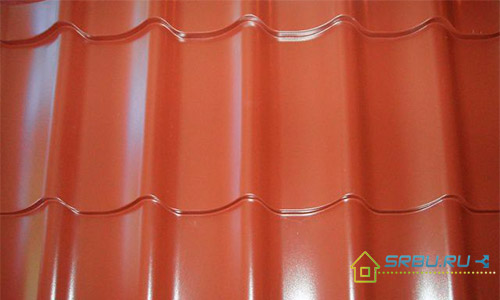
Plastisol - PVC coating
In this coating, which has a very solid thickness (from 100 to 200 microns), plasticizers are added to the polyvinyl chloride. The external texture is similar to leather or birch bark. It should be noted that varieties of metal with a plastisol coating are well suited for organizing gutters or creating roofing sheds and other household structures. The temperature limit is from plus 10 to plus 60 degrees Celsius.

PVDF coating - excellent weather protection
The tile covered with this material not only looks very elegant. She also copes well with corrosion attacks, perfectly withstanding all the unpleasant weather "surprises". Coating thickness - 27 microns. This is enough to withstand heat, cold and hail storms.

Kami TerraPLEGEL - composite metal tile
It is a multilayer coating consisting of 2 layers of polymer, quartz sand and an outer layer of polyester. Thanks to the quartz sand layer, the coating is the most resistant to mechanical damage. Terraplegel has a rough surface imitating natural tiles, it does not shine in the sun and muffles the sound of rain, which is very important for a metal tile.

Solano
Solano's coating has an original, dot-embossed texture. The thickness of the polymer layer is 200 μm. It is not subject to mechanical damage and perfectly protects against corrosion. Manufacturer's warranty up to 50 years.
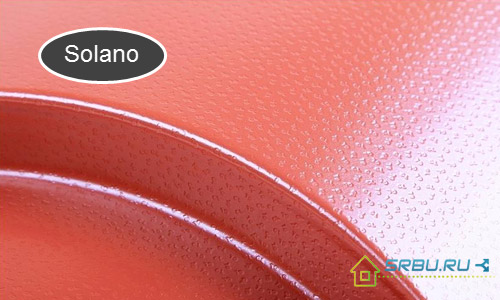
Comparison of technical characteristics of polymer coatings of metal
| Type of coating | Thickness, μm | Max. pace., 0C | Min pace. are flexible 0C | Resistance fading | Sustainability to corrosion | Durability to the fur. air | Operational period, years |
|---|---|---|---|---|---|---|---|
| Glossy Polyester | 25 - 28 | 120 | - 10 | Low | Average | Low | 10 |
| Matte Polyester | 35 | 120 | - 10 | Average | Average | Low | 15 |
| Pural | 50 | 100 | - 15 | Average | High | Average | 50 |
| Matte Pural | 50 | 100 | - 15 | High | High | Average | 50 |
| Purex | 26 | 100 | - 15 | Average | High | High | 40 |
| Prisma | 50 | 120 | - | High | High | Average | 20 |
| Plastisol | 200 | 60 | + 10 | Average | High | High | 30 |
| PVDF | 27 | 110 | - 10 | High | High | Low | 35 |
| Solano | 200 | 60 | + 10 | High | High | High | 70 |

